engine JEEP GRAND CHEROKEE 2014 WK2 / 4.G Workshop Manual
[x] Cancel search | Manufacturer: JEEP, Model Year: 2014, Model line: GRAND CHEROKEE, Model: JEEP GRAND CHEROKEE 2014 WK2 / 4.GPages: 220, PDF Size: 6.12 MB
Page 181 of 220
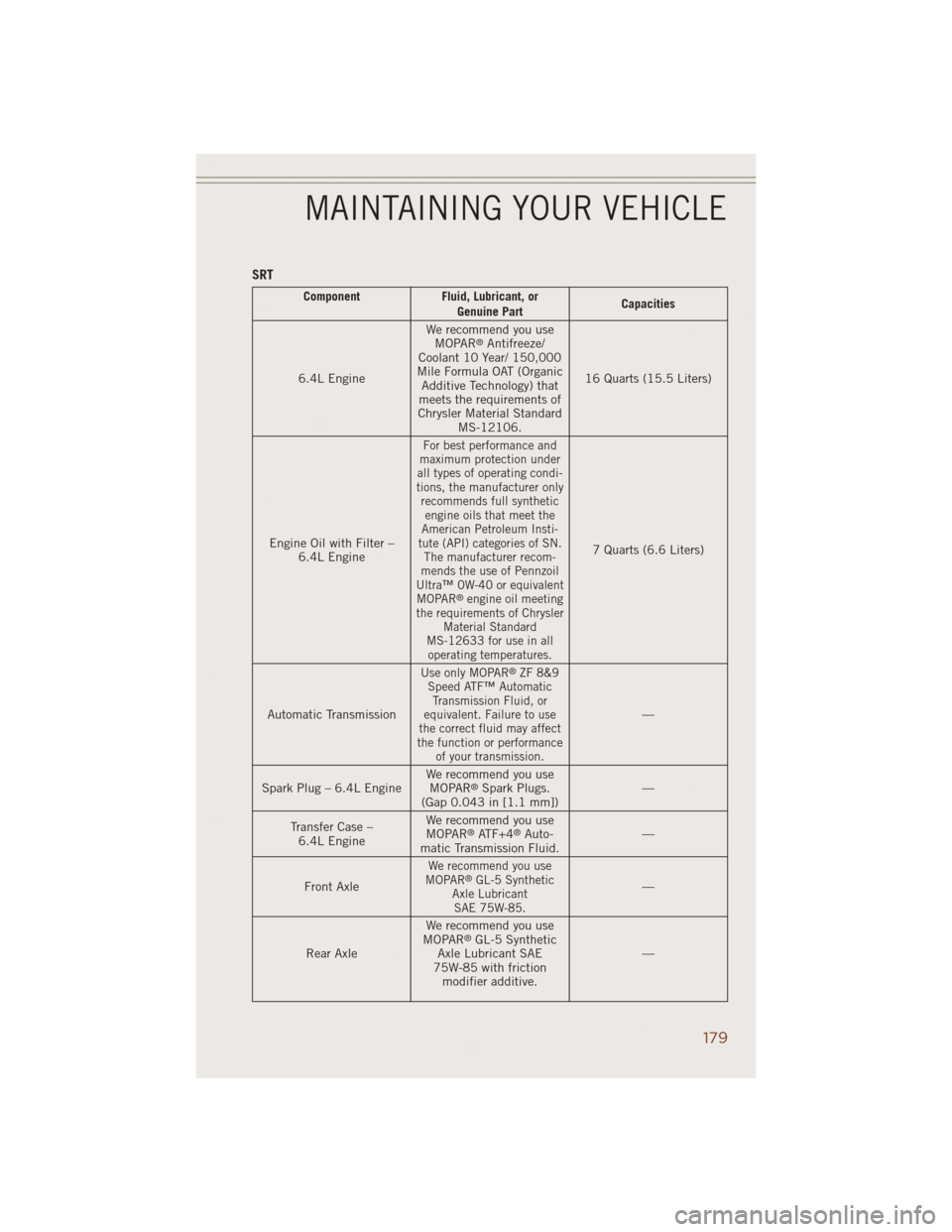
SRT
Component Fluid, Lubricant, or
Genuine PartCapacities
6.4L EngineWe recommend you use
MOPAR
®Antifreeze/
Coolant 10 Year/ 150,000
Mile Formula OAT (Organic
Additive Technology) that
meets the requirements of
Chrysler Material Standard
MS-12106.16 Quarts (15.5 Liters)
Engine Oil with Filter –
6.4L Engine
For best performance and
maximum protection under
all types of operating condi-
tions, the manufacturer only
recommends full synthetic
engine oils that meet the
American Petroleum Insti-
tute (API) categories of SN.
The manufacturer recom-
mends the use of Pennzoil
Ultra™ 0W-40 or equivalent
MOPAR
®engine oil meeting
the requirements of Chrysler
Material Standard
MS-12633 for use in all
operating temperatures.
7 Quarts (6.6 Liters)
Automatic Transmission
Use only MOPAR®ZF 8&9
Speed ATF™ Automatic
Transmission Fluid, or
equivalent. Failure to use
the correct fluid may affect
the function or performance
of your transmission.
—
Spark Plug – 6.4L EngineWe recommend you use
MOPAR
®Spark Plugs.
(Gap 0.043 in [1.1 mm])—
Transfer Case –
6.4L EngineWe recommend you use
MOPAR
®ATF+4®Auto-
matic Transmission Fluid.—
Front Axle
We recommend you use
MOPAR®GL-5 Synthetic
Axle Lubricant
SAE 75W-85.—
Rear AxleWe recommend you use
MOPAR
®GL-5 Synthetic
Axle Lubricant SAE
75W-85 with friction
modifier additive.—
MAINTAINING YOUR VEHICLE
179
Page 182 of 220
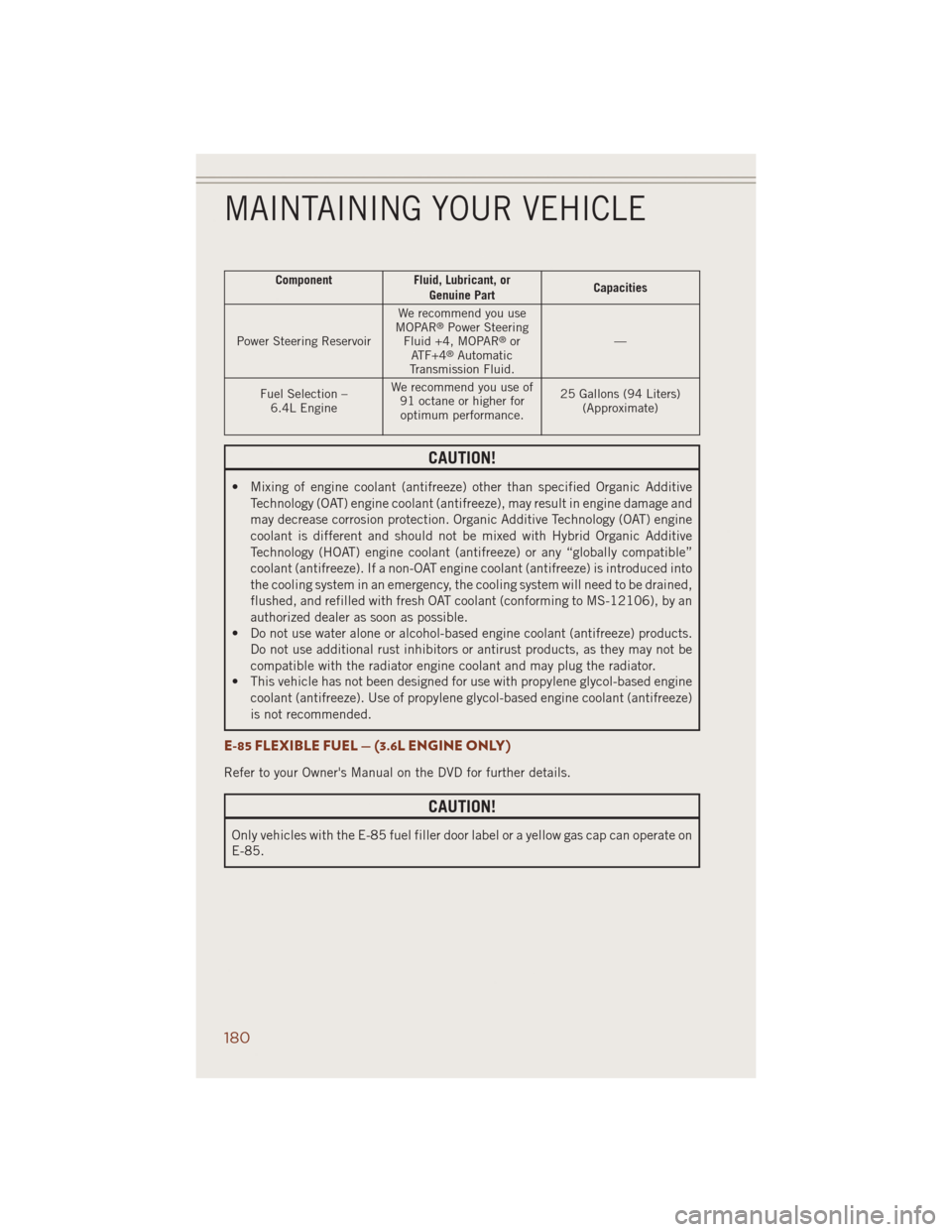
Component Fluid, Lubricant, or
Genuine PartCapacities
Power Steering ReservoirWe recommend you use
MOPAR
®Power Steering
Fluid +4, MOPAR®or
ATF+4®Automatic
Transmission Fluid.—
Fuel Selection –
6.4L EngineWe recommend you use of
91 octane or higher for
optimum performance.25 Gallons (94 Liters)
(Approximate)
CAUTION!
• Mixing of engine coolant (antifreeze) other than specified Organic Additive
Technology (OAT) engine coolant (antifreeze), may result in engine damage and
may decrease corrosion protection. Organic Additive Technology (OAT) engine
coolant is different and should not be mixed with Hybrid Organic Additive
Technology (HOAT) engine coolant (antifreeze) or any “globally compatible”
coolant (antifreeze). If a non-OAT engine coolant (antifreeze) is introduced into
the cooling system in an emergency, the cooling system will need to be drained,
flushed, and refilled with fresh OAT coolant (conforming to MS-12106), by an
authorized dealer as soon as possible.
• Do not use water alone or alcohol-based engine coolant (antifreeze) products.
Do not use additional rust inhibitors or antirust products, as they may not be
compatible with the radiator engine coolant and may plug the radiator.
• This vehicle has not been designed for use with propylene glycol-based engine
coolant (antifreeze). Use of propylene glycol-based engine coolant (antifreeze)
is not recommended.
E-85 FLEXIBLE FUEL — (3.6L ENGINE ONLY)
Refer to your Owner's Manual on the DVD for further details.
CAUTION!
Only vehicles with the E-85 fuel filler door label or a yellow gas cap can operate on
E-85.
MAINTAINING YOUR VEHICLE
180
Page 183 of 220
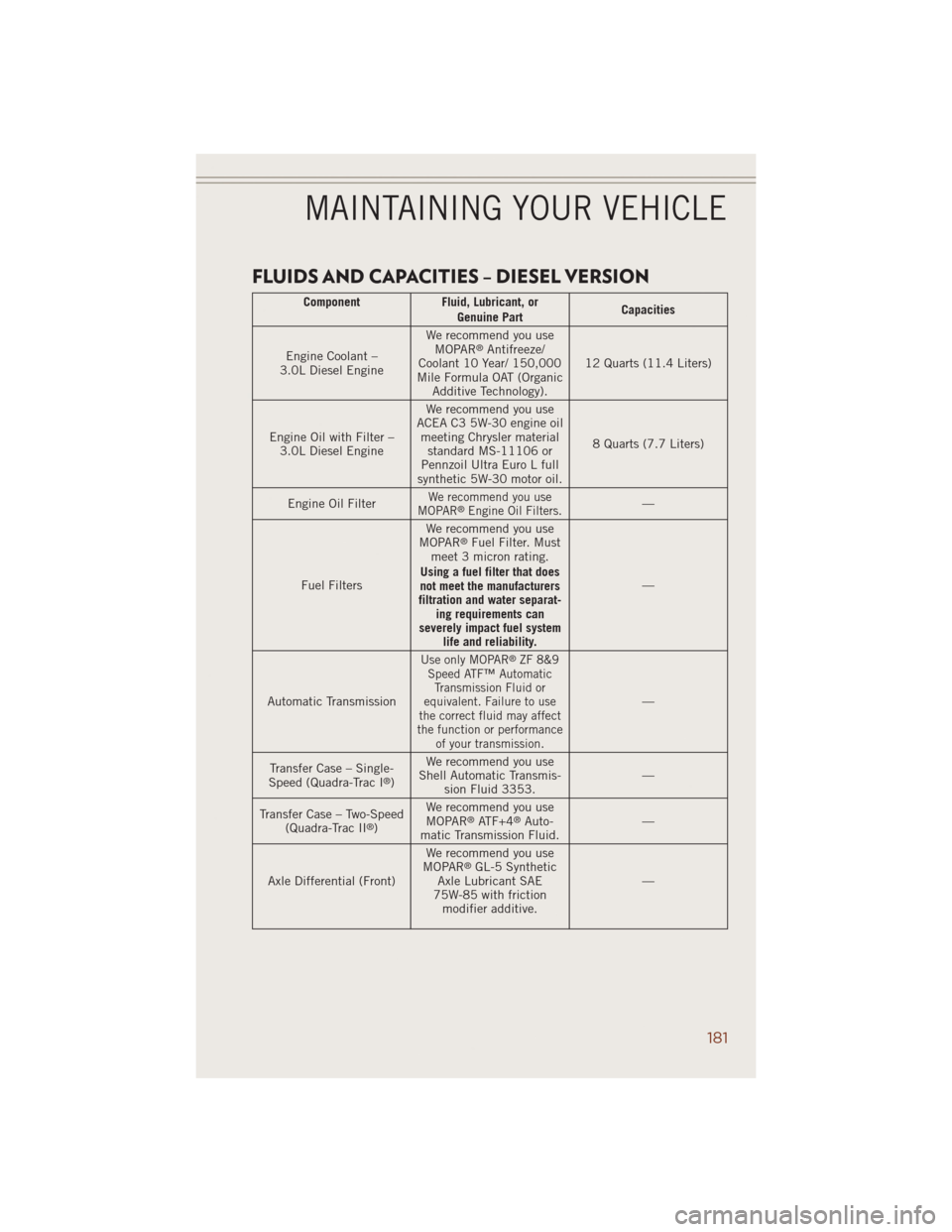
FLUIDS AND CAPACITIES – DIESEL VERSION
Component Fluid, Lubricant, or
Genuine PartCapacities
Engine Coolant –
3.0L Diesel EngineWe recommend you use
MOPAR
®Antifreeze/
Coolant 10 Year/ 150,000
Mile Formula OAT (Organic
Additive Technology).12 Quarts (11.4 Liters)
Engine Oil with Filter –
3.0L Diesel EngineWe recommend you use
ACEA C3 5W-30 engine oil
meeting Chrysler material
standard MS-11106 or
Pennzoil Ultra Euro L full
synthetic 5W-30 motor oil.8 Quarts (7.7 Liters)
Engine Oil Filter
We recommend you use
MOPAR®Engine Oil Filters.—
Fuel FiltersWe recommend you use
MOPAR
®Fuel Filter. Must
meet 3 micron rating.
Using a fuel filter that does
not meet the manufacturers
filtration and water separat-
ing requirements can
severely impact fuel system
life and reliability.—
Automatic Transmission
Use only MOPAR®ZF 8&9
Speed ATF™ Automatic
Transmission Fluid or
equivalent. Failure to use
the correct fluid may affect
the function or performance
of your transmission.
—
Transfer Case – Single-
Speed (Quadra-Trac I
®)We recommend you use
Shell Automatic Transmis-
sion Fluid 3353.—
Transfer Case – Two-Speed
(Quadra-Trac II
®)We recommend you use
MOPAR®ATF+4®Auto-
matic Transmission Fluid.—
Axle Differential (Front)We recommend you use
MOPAR
®GL-5 Synthetic
Axle Lubricant SAE
75W-85 with friction
modifier additive.—
MAINTAINING YOUR VEHICLE
181
Page 184 of 220
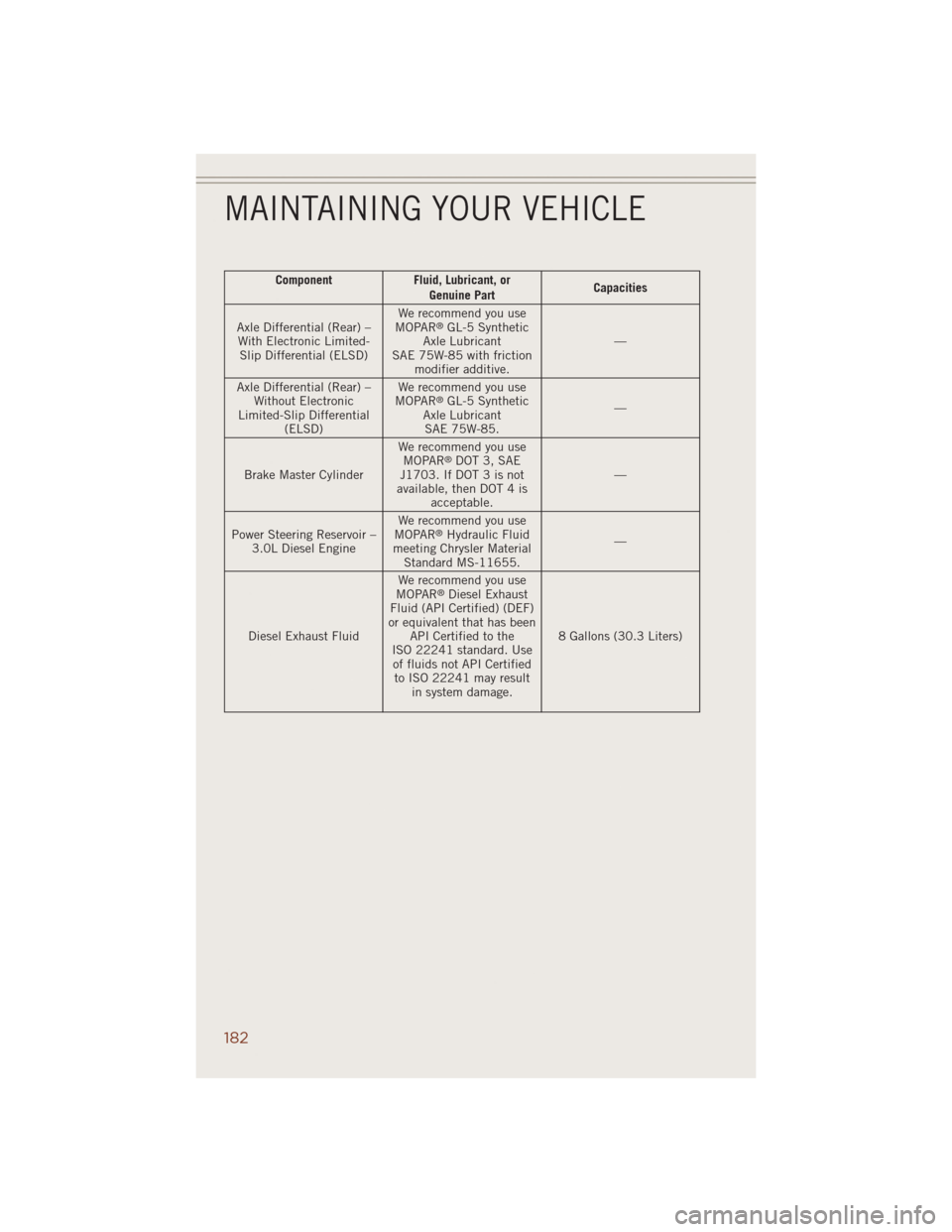
Component Fluid, Lubricant, or
Genuine PartCapacities
Axle Differential (Rear) –
With Electronic Limited-
Slip Differential (ELSD)We recommend you use
MOPAR
®GL-5 Synthetic
Axle Lubricant
SAE 75W-85 with friction
modifier additive.—
Axle Differential (Rear) –
Without Electronic
Limited-Slip Differential
(ELSD)We recommend you use
MOPAR
®GL-5 Synthetic
Axle Lubricant
SAE 75W-85.—
Brake Master CylinderWe recommend you use
MOPAR
®DOT 3, SAE
J1703. If DOT 3 is not
available, then DOT 4 is
acceptable.—
Power Steering Reservoir –
3.0L Diesel EngineWe recommend you use
MOPAR
®Hydraulic Fluid
meeting Chrysler Material
Standard MS-11655.—
Diesel Exhaust FluidWe recommend you use
MOPAR
®Diesel Exhaust
Fluid (API Certified) (DEF)
or equivalent that has been
API Certified to the
ISO 22241 standard. Use
of fluids not API Certified
to ISO 22241 may result
in system damage.8 Gallons (30.3 Liters)
MAINTAINING YOUR VEHICLE
182
Page 185 of 220
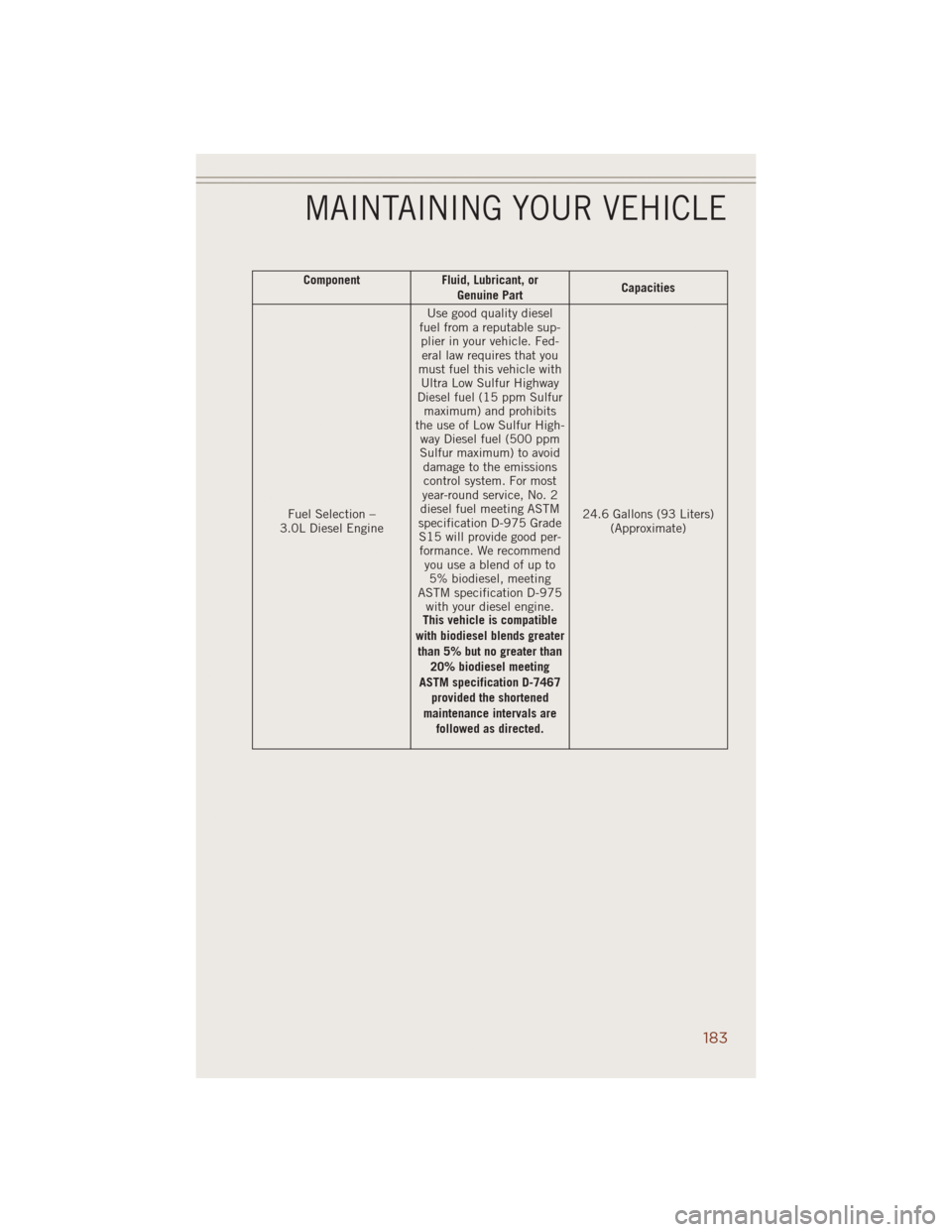
Component Fluid, Lubricant, or
Genuine PartCapacities
Fuel Selection –
3.0L Diesel EngineUse good quality diesel
fuel from a reputable sup-
plier in your vehicle. Fed-
eral law requires that you
must fuel this vehicle with
Ultra Low Sulfur Highway
Diesel fuel (15 ppm Sulfur
maximum) and prohibits
the use of Low Sulfur High-
way Diesel fuel (500 ppm
Sulfur maximum) to avoid
damage to the emissions
control system. For most
year-round service, No. 2
diesel fuel meeting ASTM
specification D-975 Grade
S15 will provide good per-
formance. We recommend
youuseablendofupto
5% biodiesel, meeting
ASTM specification D-975
with your diesel engine.
This vehicle is compatible
with biodiesel blends greater
than 5% but no greater than
20% biodiesel meeting
ASTM specification D-7467
provided the shortened
maintenance intervals are
followed as directed.24.6 Gallons (93 Liters)
(Approximate)
MAINTAINING YOUR VEHICLE
183
Page 186 of 220
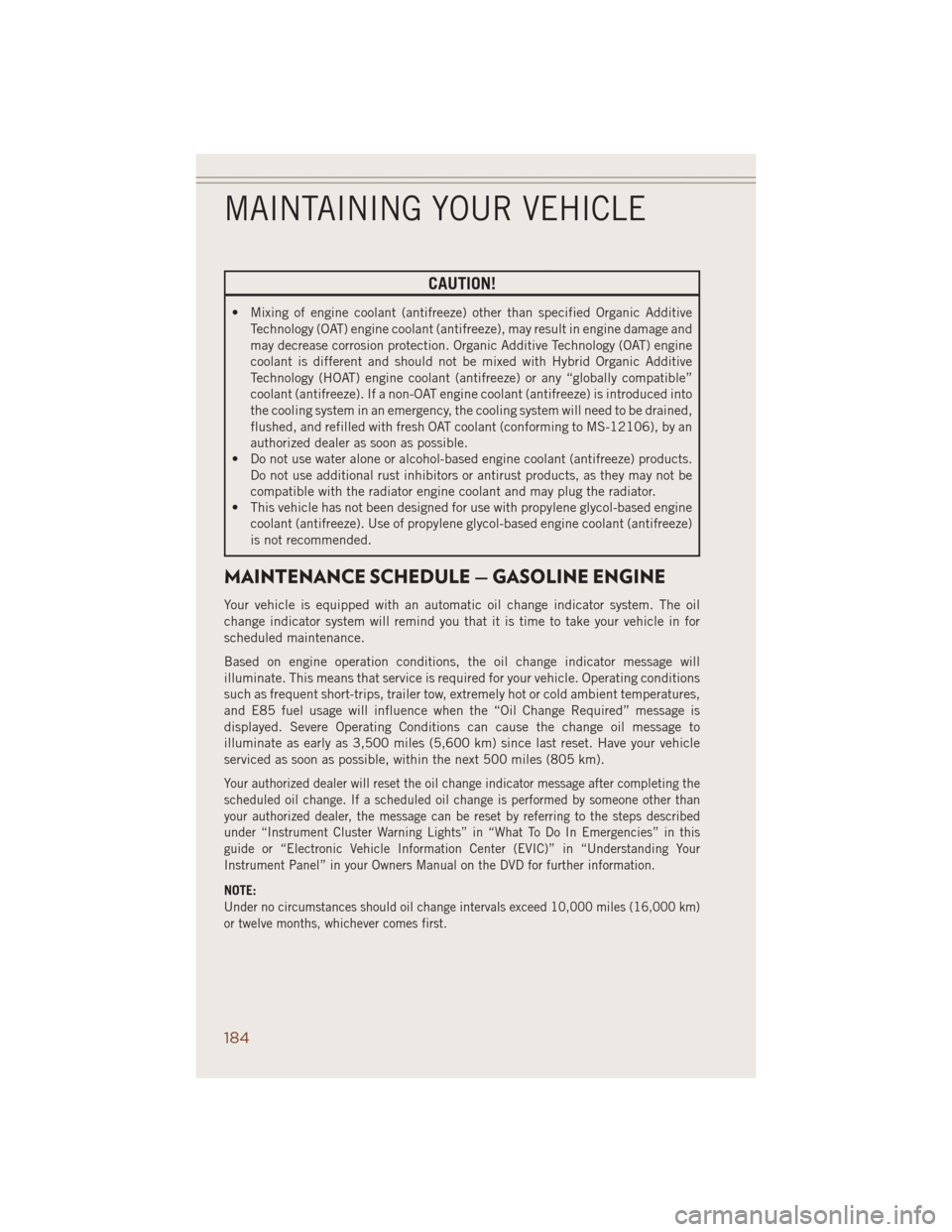
CAUTION!
• Mixing of engine coolant (antifreeze) other than specified Organic Additive
Technology (OAT) engine coolant (antifreeze), may result in engine damage and
may decrease corrosion protection. Organic Additive Technology (OAT) engine
coolant is different and should not be mixed with Hybrid Organic Additive
Technology (HOAT) engine coolant (antifreeze) or any “globally compatible”
coolant (antifreeze). If a non-OAT engine coolant (antifreeze) is introduced into
the cooling system in an emergency, the cooling system will need to be drained,
flushed, and refilled with fresh OAT coolant (conforming to MS-12106), by an
authorized dealer as soon as possible.
• Do not use water alone or alcohol-based engine coolant (antifreeze) products.
Do not use additional rust inhibitors or antirust products, as they may not be
compatible with the radiator engine coolant and may plug the radiator.
• This vehicle has not been designed for use with propylene glycol-based engine
coolant (antifreeze). Use of propylene glycol-based engine coolant (antifreeze)
is not recommended.
MAINTENANCE SCHEDULE — GASOLINE ENGINE
Your vehicle is equipped with an automatic oil change indicator system. The oil
change indicator system will remind you that it is time to take your vehicle in for
scheduled maintenance.
Based on engine operation conditions, the oil change indicator message will
illuminate. This means that service is required for your vehicle. Operating conditions
such as frequent short-trips, trailer tow, extremely hot or cold ambient temperatures,
and E85 fuel usage will influence when the “Oil Change Required” message is
displayed. Severe Operating Conditions can cause the change oil message to
illuminate as early as 3,500 miles (5,600 km) since last reset. Have your vehicle
serviced as soon as possible, within the next 500 miles (805 km).
Your authorized dealer will reset the oil change indicator message after completing the
scheduled oil change. If a scheduled oil change is performed by someone other than
your authorized dealer, the message can be reset by referring to the steps described
under “Instrument Cluster Warning Lights” in “What To Do In Emergencies” in this
guide or “Electronic Vehicle Information Center (EVIC)” in “Understanding Your
Instrument Panel” in your Owners Manual on the DVD for further information.
NOTE:
Under no circumstances should oil change intervals exceed 10,000 miles (16,000 km)
or twelve months, whichever comes first.
MAINTAINING YOUR VEHICLE
184
Page 187 of 220
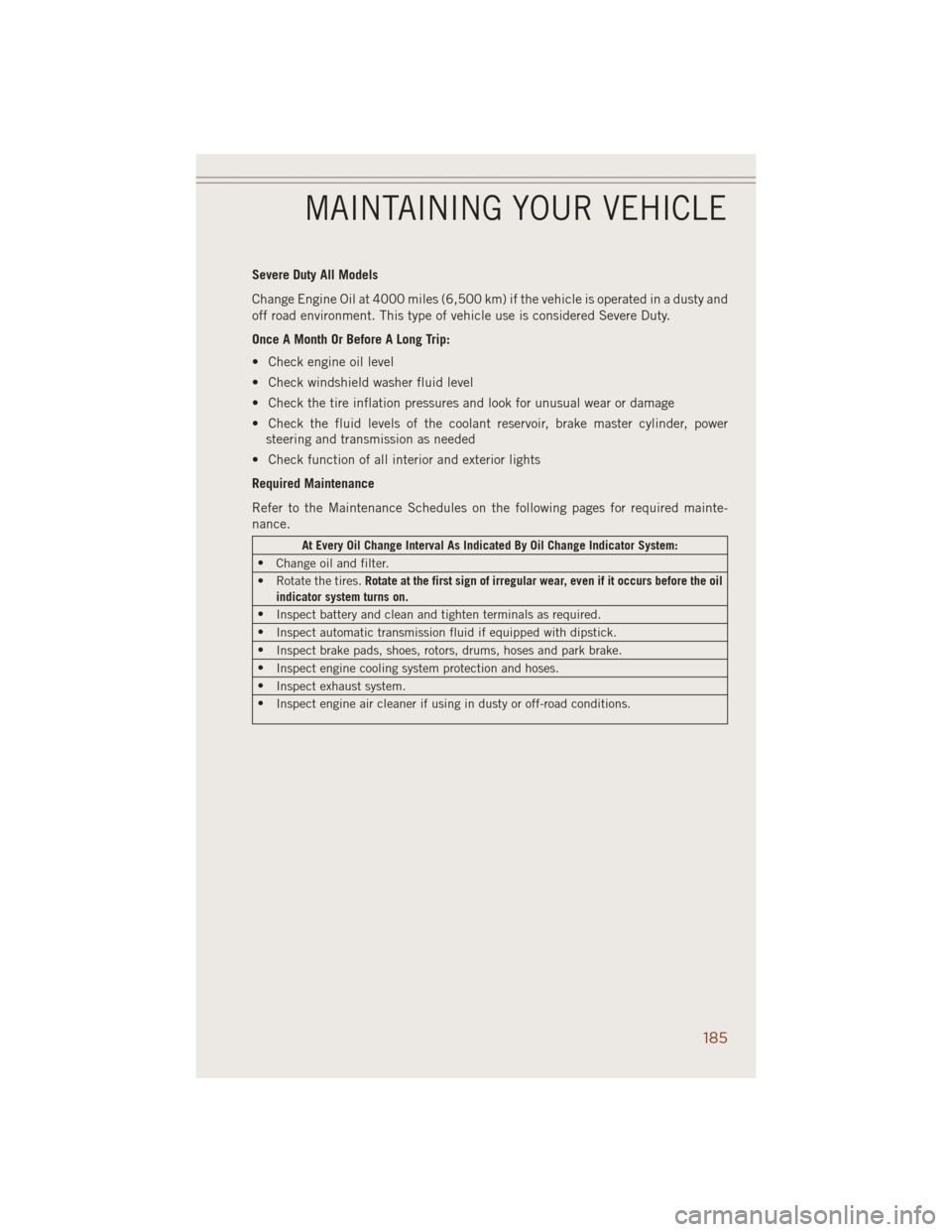
Severe Duty All Models
Change Engine Oil at 4000 miles (6,500 km) if the vehicle is operated in a dusty and
off road environment. This type of vehicle use is considered Severe Duty.
Once A Month Or Before A Long Trip:
• Check engine oil level
• Check windshield washer fluid level
• Check the tire inflation pressures and look for unusual wear or damage
• Check the fluid levels of the coolant reservoir, brake master cylinder, power
steering and transmission as needed
• Check function of all interior and exterior lights
Required Maintenance
Refer to the Maintenance Schedules on the following pages for required mainte-
nance.
At Every Oil Change Interval As Indicated By Oil Change Indicator System:
•
Change oil and filter.
• Rotate the tires.Rotate at the first sign of irregular wear, even if it occurs before the oil
indicator system turns on.
•
Inspect battery and clean and tighten terminals as required.
•
Inspect automatic transmission fluid if equipped with dipstick.
•
Inspect brake pads, shoes, rotors, drums, hoses and park brake.
•
Inspect engine cooling system protection and hoses.
•
Inspect exhaust system.
•
Inspect engine air cleaner if using in dusty or off-road conditions.
MAINTAINING YOUR VEHICLE
185
Page 188 of 220
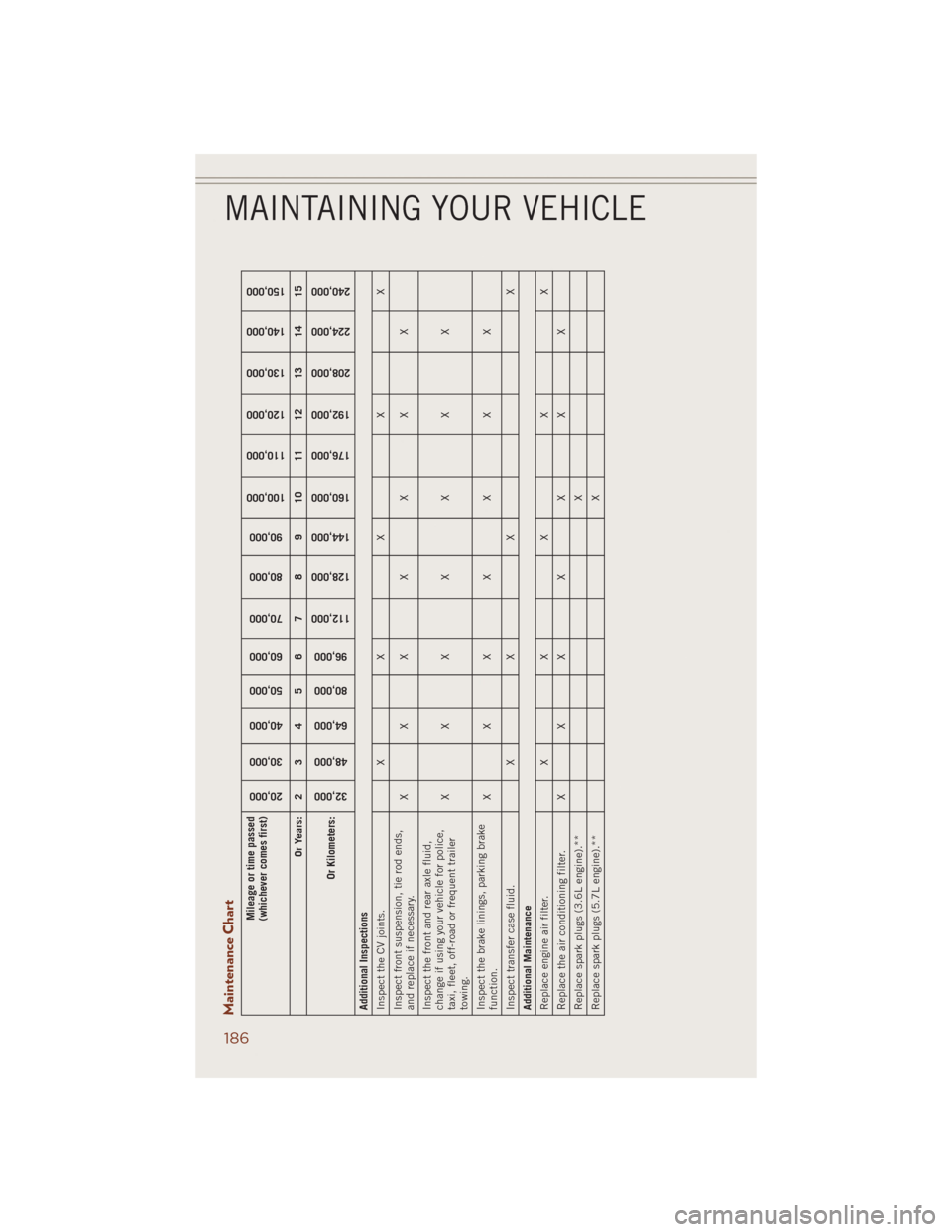
Maintenance Chart
Mileage or time passed
(whichever comes first)
20,000
30,000
40,000
50,000
60,000
70,000
80,000
90,000
100,000
110,000
120,000
130,000
140,000
150,000
Or Years: 2 3 4 5 6 7 8 9 10 11 12 13 14 15
Or Kilometers:
32,000
48,000
64,000
80,000
96,000
112,000
128,000
144,000
160,000
176,000
192,000
208,000
224,000
240,000
Additional Inspections
Inspect the CV joints. X X X X X
Inspect front suspension, tie rod ends,
and replace if necessary.XXX X X X X
Inspect the front and rear axle fluid,
change if using your vehicle for police,
taxi, fleet, off-road or frequent trailer
towing.XXX X X X X
Inspect the brake linings, parking brake
function.XXX X X X X
Inspect transfer case fluid. X X X X
Additional Maintenance
Replace engine air filter. X X X X X
Replace the air conditioning filter. X X X X X X X
Replace spark plugs (3.6L engine).** X
Replace spark plugs (5.7L engine).** X
MAINTAINING YOUR VEHICLE
186
Page 189 of 220
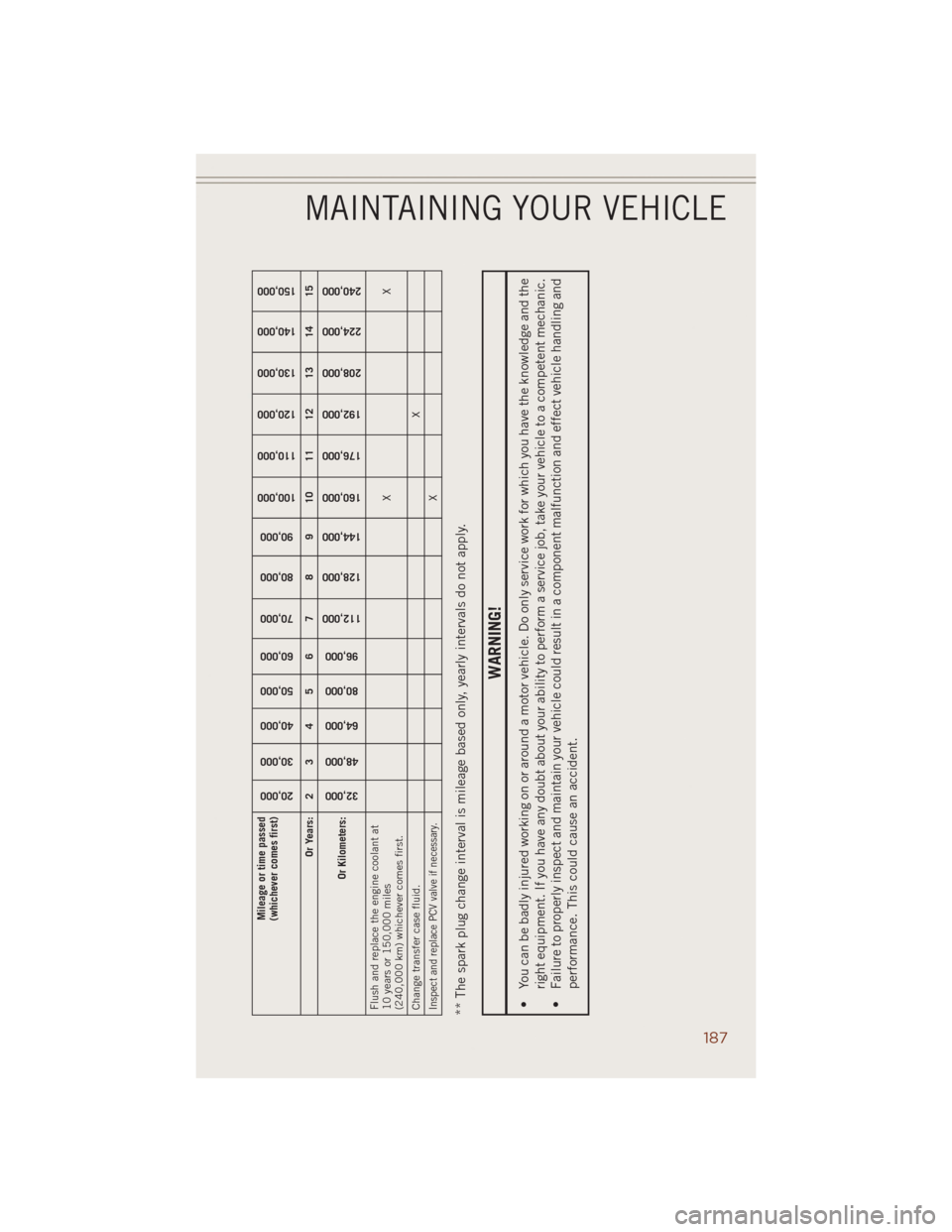
Mileage or time passed
(whichever comes first)
20,000
30,000
40,000
50,000
60,000
70,000
80,000
90,000
100,000
110,000
120,000
130,000
140,000
150,000
Or Years: 2 3 4 5 6 7 8 9 10 11 12 13 14 15
Or Kilometers:
32,000
48,000
64,000
80,000
96,000
112,000
128,000
144,000
160,000
176,000
192,000
208,000
224,000
240,000
Flush and replace the engine coolant at
10 years or 150,000 miles
(240,000 km) whichever comes first.XX
Change transfer case fluid.XInspect and replace PCV valve if necessary.
X
** The spark plug change interval is mileage based only, yearly intervals do not apply.
WARNING!
• You can be badly injured working on or around a motor vehicle. Do only service work for which you have the knowledge and the
right equipment. If you have any doubt about your ability to perform a service job, take your vehicle to a competent mechanic.
• Failure to properly inspect and maintain your vehicle could result in a component malfunction and effect vehicle handling and
performance. This could cause an accident.
MAINTAINING YOUR VEHICLE
187
Page 191 of 220
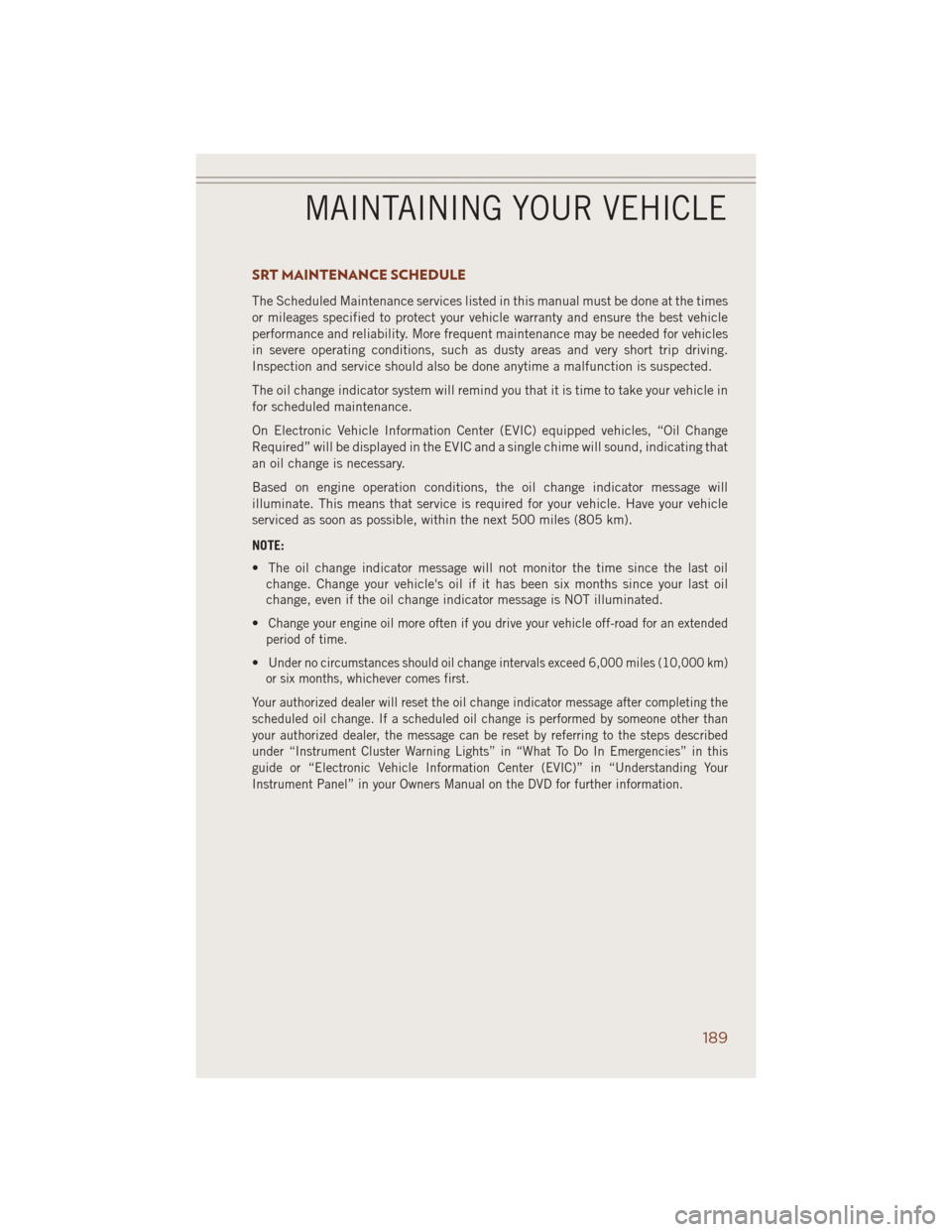
SRT MAINTENANCE SCHEDULE
The Scheduled Maintenance services listed in this manual must be done at the times
or mileages specified to protect your vehicle warranty and ensure the best vehicle
performance and reliability. More frequent maintenance may be needed for vehicles
in severe operating conditions, such as dusty areas and very short trip driving.
Inspection and service should also be done anytime a malfunction is suspected.
The oil change indicator system will remind you that it is time to take your vehicle in
for scheduled maintenance.
On Electronic Vehicle Information Center (EVIC) equipped vehicles, “Oil Change
Required” will be displayed in the EVIC and a single chime will sound, indicating that
an oil change is necessary.
Based on engine operation conditions, the oil change indicator message will
illuminate. This means that service is required for your vehicle. Have your vehicle
serviced as soon as possible, within the next 500 miles (805 km).
NOTE:
• The oil change indicator message will not monitor the time since the last oil
change. Change your vehicle's oil if it has been six months since your last oil
change, even if the oil change indicator message is NOT illuminated.
•
Change your engine oil more often if you drive your vehicle off-road for an extended
period of time.
•Under no circumstances should oil change intervals exceed 6,000 miles (10,000 km)
or six months, whichever comes first.
Your authorized dealer will reset the oil change indicator message after completing the
scheduled oil change. If a scheduled oil change is performed by someone other than
your authorized dealer, the message can be reset by referring to the steps described
under “Instrument Cluster Warning Lights” in “What To Do In Emergencies” in this
guide or “Electronic Vehicle Information Center (EVIC)” in “Understanding Your
Instrument Panel” in your Owners Manual on the DVD for further information.
MAINTAINING YOUR VEHICLE
189